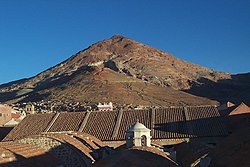Potosí
| Potosí | |||
|---|---|---|---|

View of Rich Hill (Cerro Rico) and National Mint
|
|||
|
|||
| Nickname(s): Imperial Villa (Villa Imperial in Spanish) | |||
| Location in Bolivia | |||
| Coordinates: 19°35′S 65°45′W / 19.583°S 65.750°WCoordinates: 19°35′S 65°45′W / 19.583°S 65.750°W | |||
| Country | Bolivia | ||
| Department | Potosí | ||
| Province | Tomás Frías | ||
| Municipality | Potosí Municipality | ||
| Founded | April 1, 1545 | ||
| Government | |||
| • Mayor | René Joaquino Cabrera | ||
| Area | |||
| • Total | 118.218 km2 (45.6 sq mi) | ||
| Elevation | 4,067 m (13,343 ft) | ||
| Population (2012) | |||
| • Total | 240,966 | ||
| • Density | 2,000/km2 (5,300/sq mi) | ||
| Time zone | UTC-4 | ||
| Website | Official website | ||
| Official name | City of Potosí | ||
| Type | Cultural | ||
| Criteria | ii, iv, vi | ||
| Designated | 1987 (11th session) | ||
| Reference no. | 420 | ||
| State Party | Bolivia | ||
| Region | Latin America and the Caribbean | ||
Potosí is a city and the capital of the department of Potosí in Bolivia. It is one of the highest cities in the world at a nominal 4,090 metres (13,420 ft). For centuries, it was the location of the Spanish colonial mint.
Potosí lies at the foot of the Cerro de Potosí—sometimes referred to as the Cerro Rico ("rich mountain") — a mountain popularly conceived of as being "made of" silver ore that dominates the city. The Cerro Rico is the reason for Potosí's historical importance, since it was the major supply of silver for Spain during the period of the New World Spanish Empire.
The silver was taken by llama and mule train to the Pacific coast, shipped north to Panama City, and carried by mule train across the isthmus of Panama to Nombre de Dios or Portobelo, whence it was taken to Spain on the Spanish treasure fleets. Some of the silver also made its way east to Buenos Aires, via the Rio de la Plata.
Cerro de Potosí's peak is 4,824 metres (15,827 ft) above sea level.
Located in the Bolivian Tin Belt, Cerro Rico de Potosi is the world's largest silver deposit and has been mined since the sixteenth century, producing up to 60,000 tonnes by 1996. Estimates are that much silver still remains in the mines. Potosi became the second largest city, and the site of the first mint, in the Americas. By 1891, low silver prices prompted the change to mining tin, which continued until 1985. At peak production in the sixteenth and seventeenth centuries, the ore contained up to 40% silver.
...
Wikipedia



